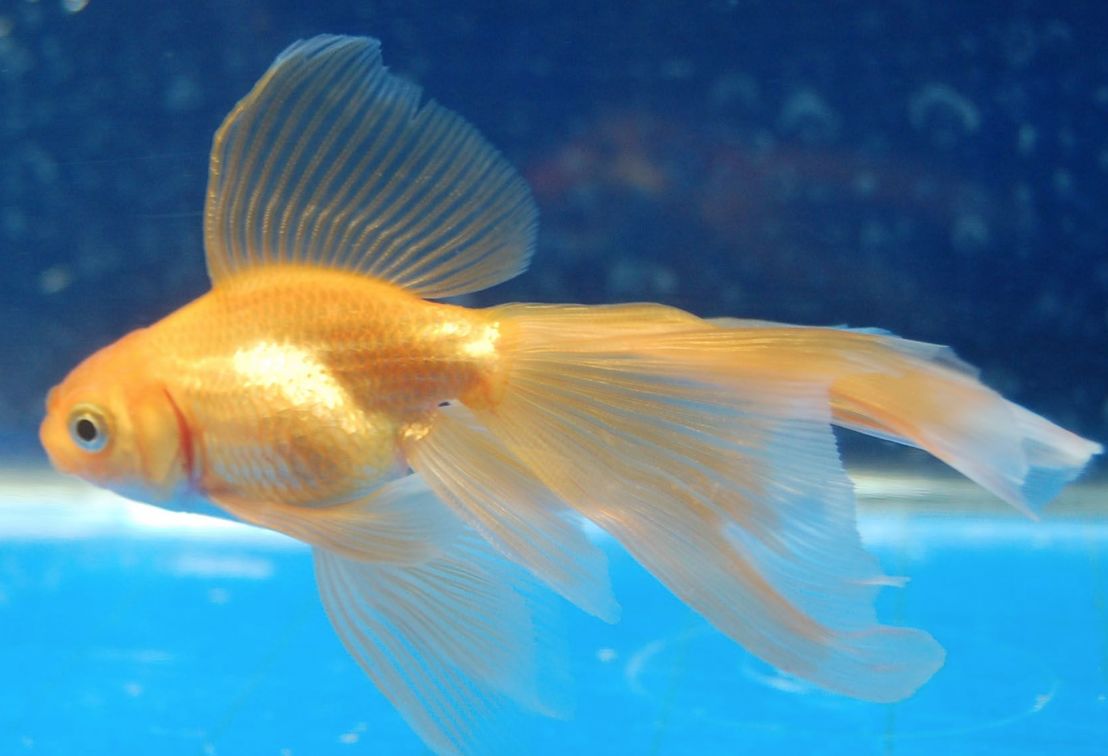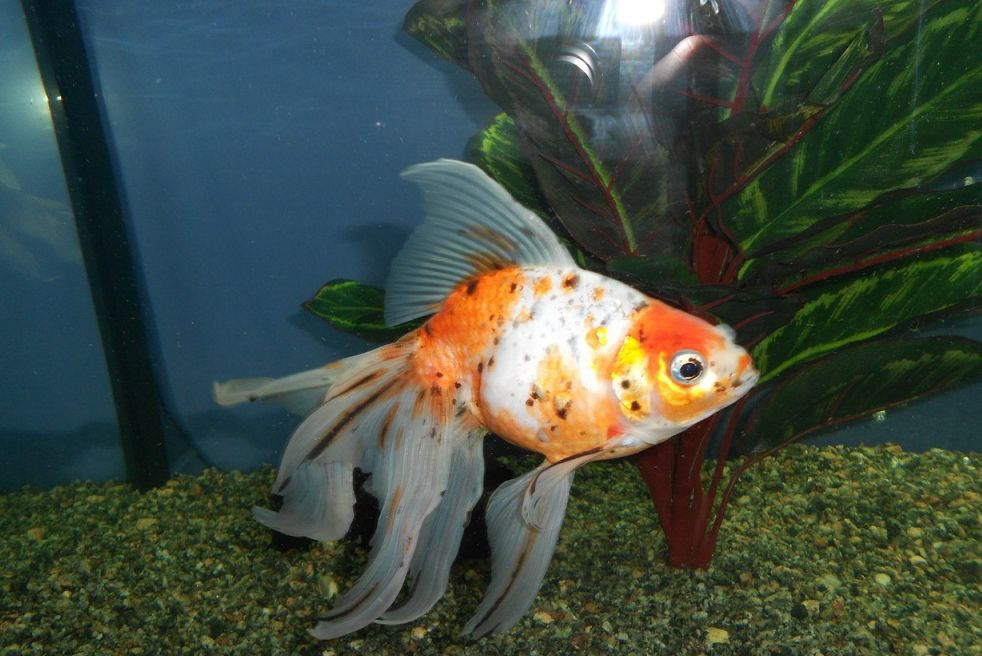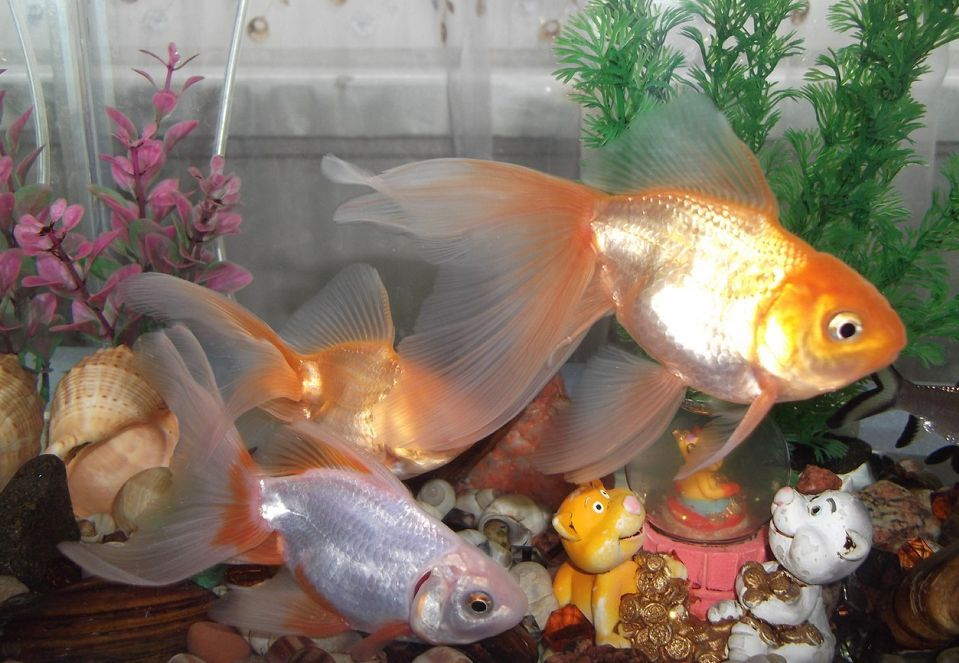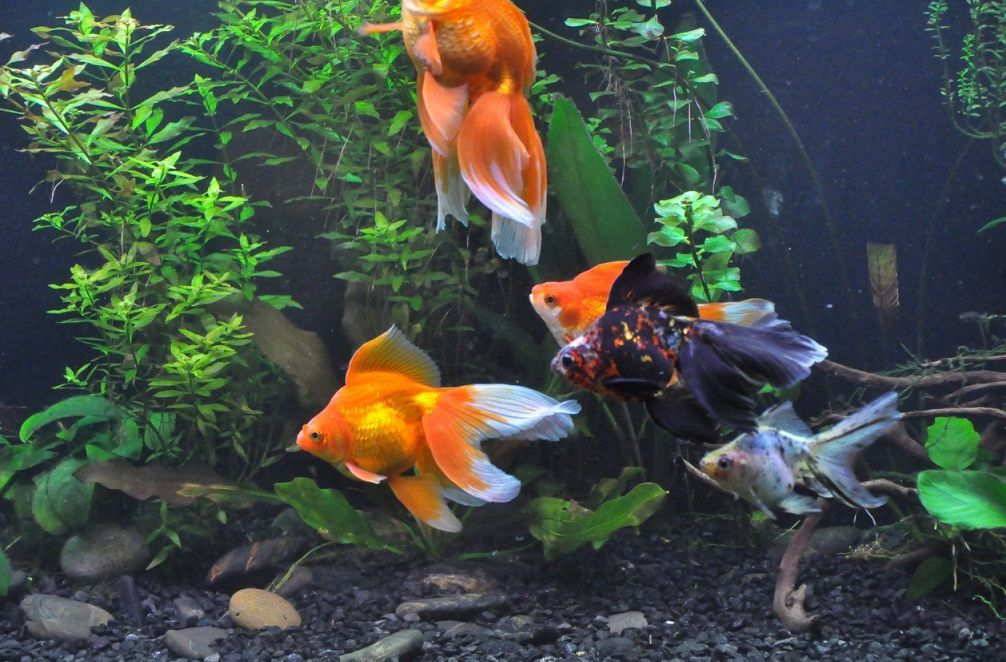The veiltail goldfish is a popular ornamental breed, well-known for its striking elongated fins and a unique, fluffy tail that is notably longer than those of other goldfish varieties. This fish is an excellent choice for beginner aquarists due to its hardiness, although it does come with certain care considerations.
Veiltail goldfish are relatively undemanding; however, they require a suitable environment to thrive. One important aspect to keep in mind is their tendency to dig in the substrate, which can disturb the tank setup. Additionally, these fish have a hearty appetite and often overeat, which can lead to health issues. It’s crucial to monitor their feeding and provide a balanced diet to prevent overeating.
Moreover, veiltail goldfish prefer cooler water temperatures, making them ideal for unheated aquariums or outdoor ponds in moderate climates. By understanding these essential care tips, beginners can enjoy a thriving veiltail goldfish in their aquarium.

Contents
Habitat in the wild
The veiltail goldfish, like other varieties of goldfish, cannot be found in the wild. Its ancestor, the common carp, is widespread in nature, which contributes to the veiltail’s hardiness and low maintenance requirements. This lineage makes the veiltail goldfish a resilient choice for aquarists.
Recognized for its distinctive long, flowing double tail, the veiltail goldfish embodies elegance and grace. The history of this breed can be traced back over a thousand years to ancient China, where goldfish breeding began. Through selective breeding, early aquarists chose specimens with longer tail fins, refining these traits over generations. The outcome was a fish with a beautiful, veil-like tail that enhances its aesthetic appeal.
While the exact timeline of the veiltail’s development is not well-documented, it gained popularity in the Western world during the late 1800s and early 1900s, when goldfish became increasingly sought after as ornamental pets. The veiltail’s flowing appearance differentiates it from other goldfish varieties, though its long fins can make swimming more challenging. Therefore, special care is needed to prevent damage to these delicate fins.
Over the years, veiltail goldfish have been further refined through selective breeding to enhance their color, fin length, and overall appearance. Today, they are available in a variety of colors, including red, orange, white, black, and calico patterns. Breeders focus on selecting the finest specimens, ensuring that those with the longest fins are chosen for further breeding.
| Characteristic | Description |
|---|---|
| Body Shape | Compressed, oval body shape |
| Tail Type | Double tail, long and flowing |
| Finnage | Long, delicate fins with a veil-like appearance |
| Coloration | Wide variety of colors, including red, orange, white, black, and calico patterns |
| Size | Can grow up to 6-8 inches (15-20 cm) in length |
| Swimming Ability | Tail structure may slightly hinder swimming, requiring a spacious tank with smooth surfaces |
| Behavior | Peaceful, social, and compatible with other goldfish; may exhibit slow and graceful movement |
| Care | Requires clean, well-maintained water with appropriate filtration; delicate fins prone to damage |
| Diet | Omnivorous; should be fed a balanced diet of quality goldfish flakes, pellets, and occasional treats |
| Tank Size | Larger tank with a minimum of 20-30 gallons for a single Veiltail, more for multiple fish |
| Tankmates | Compatible with other peaceful goldfish varieties; avoid aggressive or fin-nipping species |
Description
Size
Veiltail goldfish can grow to a size typically ranging from 6 to 8 inches (15 to 20 cm) in length. Understanding their growth potential is crucial for any aquarist, as it helps inform proper tank size and care requirements.
Several factors can influence the growth of a veiltail goldfish, including genetics, diet, water quality, and the size of their tank. For instance, providing a spacious tank allows these fish to swim freely, which can promote healthy growth. A varied and balanced diet rich in nutrients is equally important, as it supports their development and overall health. Moreover, maintaining high water quality through regular changes and filtration is essential to prevent stress and disease, both of which can hinder growth.
Lifespan
The lifespan of a veiltail goldfish can vary significantly based on several factors, including the quality of care it receives, its environment, genetics, and overall health. On average, a well-cared-for veiltail goldfish can live anywhere from 5 to 10 years, with some individuals potentially living even longer under optimal conditions.
Body
The veiltail goldfish features a distinctive short, oviform, or globe-shaped body, typical of its family. The contour of its head seamlessly transitions into its back, contributing to its unique profile. Due to this body shape, the veiltail goldfish is not the most efficient swimmer, often resulting in it arriving later to food than its tank mates. This slower swimming ability can make it more vulnerable to competition for food, especially in a community tank where faster fish may dominate feeding times.
All of the fish’s fins are notably long, thin, and almost transparent, contributing to its elegant appearance. The tail fin is particularly striking; it is double in structure, incredibly long, and wide, yet somewhat thin and translucent. This long, flowing tail not only adds to the fish’s beauty but also makes it susceptible to injury. As a result, it’s important to create a tank environment with smooth surfaces and decorations to prevent any damage to the delicate fins.
The upright dorsal fin is proportionate to the fish’s body, measuring approximately half to three-quarters of its total height. This fin, while adding to the fish’s aesthetic appeal, can also impact its swimming style. The long fins require special consideration in tank design, as they can hinder movement if the space is too confined or if the water flow is too strong.
Additionally, the veiltail goldfish’s body shape and long fins can lead to stress in environments with strong currents or aggressive tank mates. Since they are not adept at navigating strong water flows, it’s crucial to keep them in calm waters, where they can swim comfortably.
Furthermore, their long fins are susceptible to injury or fin rot, which underscores the importance of regular tank maintenance. Keeping the tank clean and free from sharp decorations is vital to preserving the health of the veiltail goldfish’s fins.
Coloring
The coloring of veiltail goldfish varies widely, and there is no uniform standard for their appearance. This variety makes them a popular and visually appealing choice among goldfish enthusiasts. Veiltails can display a spectrum of colors, ranging from solid, vibrant hues to striking combinations of multiple shades. Here are some common color variations and patterns you might find in veiltail goldfish:
- Red (Orange): This is one of the most classic and sought-after colors for veiltail goldfish. Their coloration can range from a bright, fiery red to a softer orange shade, making them a standout in any aquarium.
- Calico: Calico veiltails showcase a combination of red, orange, black, and white spots or blotches on their bodies. This colorful and unique appearance gives each fish an individual personality, appealing to aquarists who appreciate diversity in their tanks.
- White: White veiltails present an elegant and striking appearance, characterized by a pure white body. They stand out beautifully in a well-maintained aquarium, especially when contrasting with colorful decorations and plants.
- Black: Black veiltails possess a deep, velvety black coloration throughout their bodies. The contrast between their black color and their flowing fins creates a visually captivating look, making them a favorite among collectors.
- Bi-color: Some veiltail goldfish display a combination of two distinct colors, often with one color on the body and another on the fins. For example, a white-bodied fish with vibrant red fins creates a visually dynamic appearance.
- Tri-color: Tri-color veiltails feature three distinct colors, resulting in intricate patterns that enhance their beauty. This variety can provide an eye-catching focal point in any aquarium.
- Chocolate: Chocolate-colored veiltails have a rich, dark brown coloration that sets them apart from more common goldfish colors. This unique hue can add depth to an aquarium’s aesthetic.
- Metallic: Metallic veiltails exhibit a shimmering, metallic sheen that enhances their beauty. This striking effect is especially prominent under good lighting conditions, making them glow in the tank.
- Blue: Although less common, some veiltail goldfish can display a bluish tint, which can vary in intensity and hue. This rare color adds an exotic touch to the variety of available options.
- Yellow: Yellow veiltails, though rarer, feature a golden yellow color that can be quite eye-catching. This unique coloration can brighten up an aquarium and attract attention.
New Fact: Color Changes with Age
As veiltail goldfish age, their colors may change significantly. This phenomenon is particularly fascinating for aquarists, as it adds an element of unpredictability to keeping these fish. For instance, a young veiltail that starts with vibrant hues may gradually develop more subdued tones or completely shift its color pattern as it matures.
The reasons behind these changes can be attributed to several factors:
Genetic Factors: Each veiltail goldfish has a unique genetic background that influences its potential for color changes. Selective breeding has led to specific traits that may become more pronounced or change as the fish matures, resulting in the emergence of unexpected colors or patterns.
Developmental Changes: During the growth stages, the fish’s skin and scales undergo various transformations, which can result in different shades and patterns. Young veiltails might display bright colors to attract mates or deter predators, while adult fish may develop more muted tones.
Environmental Influences: The environment in which the fish is kept can also impact color changes. Factors such as water quality, temperature, lighting, and stress levels can affect pigmentation. For example, consistent exposure to bright light may enhance certain colors, while poor water conditions can lead to fading.
Dietary Impact: The diet of the veiltail goldfish plays a crucial role in maintaining vibrant colors. A well-balanced diet rich in carotenoids, found in foods like spirulina and certain vegetables, can enhance the fish’s coloration. Conversely, a lack of essential nutrients can lead to dull or faded colors over time.

Difficulties in keeping
The veiltail goldfish is not particularly demanding when it comes to tank water parameters and temperature, making it a versatile choice for various aquatic environments. This species thrives in both pond settings and traditional aquariums, showcasing its adaptability. However, it is essential to remember that the veiltail goldfish prefers cooler water temperatures, which can limit its compatibility with many tropical fish.
Care and keeping in a tank
Tank size
When you hear someone talking about goldfish, you might envision a small tank with a single veiltail fish swimming gracefully. However, this is not the best way to keep this species. Veiltail goldfish can grow up to 20 cm (8 inches) in length, making them significantly larger than many people expect. Moreover, they produce a considerable amount of waste, necessitating a larger living space.
To properly accommodate one veiltail goldfish, a minimum tank size of 20 to 30 gallons (75 to 114 liters) is essential. This space allows for adequate swimming room and helps maintain water quality, which is critical for their health.
Social Behavior: It’s important to note that goldfish are inherently social creatures. They thrive better when kept with companions of their own kind. If you plan to house more than one veiltail goldfish, you will need to increase the tank size accordingly to ensure all fish have sufficient space to swim and interact comfortably.
Tank Size Guidelines: A general guideline for keeping multiple goldfish is to provide 10 to 20 gallons (38 to 76 liters) of tank volume per fish. Therefore, if you wish to keep two veiltail goldfish, a tank of at least 40 to 60 gallons (151 to 227 liters) is recommended. If you plan to maintain a small group of veiltails, an even larger tank will be necessary.
Substrate
When choosing a substrate for a tank housing veiltail goldfish, it is advisable to use either sand or large pebbles. These fish have a natural tendency to dig into the substrate, which can lead to health issues if unsuitable materials are used.
Using smaller substrate particles can result in veiltail goldfish accidentally swallowing them, potentially leading to fatal complications. For example, gravel that is too small may be ingested, causing blockages in the fish’s digestive system.
In contrast, sand and larger pebbles provide a safer environment for these active diggers. Sand allows for natural foraging behavior without the risk of swallowing dangerous particles, while larger pebbles can prevent accidental ingestion altogether.
Filtration
In addition to substrate selection, maintaining a healthy environment for your veiltail goldfish requires a good external filter and regular water changes. All goldfish species, including veiltails, have a natural instinct to dig in the substrate, which can disturb the tank environment. This behavior can lead to muddy water and even result in the uprooting of tank plants.
An efficient external filter is essential for keeping the water clean and clear. It helps to remove debris, excess food, and waste that accumulate due to the digging habits of the fish. High-quality external filters, such as canister or power filters, can provide effective biological, mechanical, and chemical filtration, ensuring a stable and healthy habitat for your goldfish.
Regular water renewal is equally important, as it helps to maintain optimal water quality by diluting harmful substances like ammonia and nitrate that build up over time. Changing 10-20% of the tank water weekly is a good practice to support the health and vitality of your veiltail goldfish.
Water parameters
While goldfish are generally hardy, they can be sensitive to poor water quality, which can lead to stress and health issues. Below are the recommended water parameters for a veiltail goldfish aquarium:
Temperature: Unlike tropical fish, goldfish prefer cooler water. You will need a heater only if the room temperature drops below 0 °C (32 °F). It is advisable to keep the tank out of direct sunlight and to maintain the water temperature below 22 °C (72 °F). Goldfish can thrive in temperatures lower than 13 °C (55 °F), making them well-suited to cooler environments. However, avoid sudden temperature fluctuations, as these can be harmful. The ideal temperature range for veiltail goldfish is typically between 18-24 °C (65-75 °F).
pH Level: The pH level should be maintained between 6.5 and 7.5, close to neutral. While goldfish can adapt to varying pH levels, stability is essential to minimize stress.
Ammonia and Nitrite: Both ammonia and nitrite levels should be kept at or near zero, as these compounds are toxic to fish and can lead to serious health issues. Regular water changes and a reliable filtration system are crucial for keeping these levels low.
Nitrate: Nitrate levels should be maintained below 40 ppm (parts per million). Conducting regular water changes is the primary method for controlling nitrate buildup.
Hardness: Goldfish can adapt to a range of water hardness, but a moderately hard water level of 6-12 dKH is generally suitable for veiltail goldfish.
Adequate Filtration: A good filtration system is vital for keeping the water clean and free from harmful compounds. Ensure your filter is appropriately sized for the tank to handle the bioload effectively.
Avoid Overcrowding: Overcrowding can lead to stress, poor water quality, and stunted growth. Be mindful of the number of fish in your aquarium to maintain a healthy environment.
Regular Water Changes: Conducting partial water changes of about 20-30% every 1-2 weeks is essential for removing accumulated waste and maintaining good water quality.
Test Water: Regularly testing the water parameters with reliable aquarium test kits will help ensure that conditions remain within the appropriate ranges for your veiltail goldfish.

Diet
Feeding veiltail goldfish requires careful attention to their eating habits to ensure their health and longevity. These fish tend to eat until all food is consumed, which can lead to overeating and potential health issues, including death. Therefore, it’s essential to accurately calculate the appropriate amount of food to provide.
Feeding Frequency: It is advisable to feed veiltail goldfish twice a day, offering portions that they can consume within one minute. This practice helps prevent overfeeding and promotes better digestion. By establishing a routine feeding schedule, you can help your goldfish develop a healthy eating pattern, which is crucial for their overall well-being.
Type of Food: The best option is to use specially formulated food designed for goldfish. This food typically comes in pellet form, which does not crumble in water, making it easier for veiltail goldfish to find and consume. Additionally, pellets allow for more precise portion control, ensuring that you can accurately measure out the amount needed for each feeding.
If specialized goldfish food is unavailable, you can provide alternative options, such as frozen, live, or artificial food. Goldfish are omnivorous and will readily eat whatever food you offer. However, be mindful of the nutritional value; overly rich foods can lead to obesity and health problems. Including a variety of food types, like high-quality flakes or gel food, can help provide a balanced diet.
Consequences of Overfeeding: Overfeeding can lead to digestive issues, swim bladder problems, and even death. A common issue among goldfish is constipation, which can result from a poor diet or excessive food intake. By monitoring portion sizes and ensuring a balanced diet, you can significantly reduce the risk of these health concerns.
Nutritional Needs: It’s essential to understand that goldfish have specific nutritional requirements that differ from those of many tropical fish. Their diet should include a mix of carbohydrates, proteins, and fats. For example, a good goldfish diet may consist of 30% protein, which can come from high-quality pellets or live foods like daphnia and brine shrimp. Incorporating plant matter, such as blanched peas or zucchini, can also be beneficial and provide essential fiber.
Feeding Behavior: Goldfish are known for their voracious appetites; they will often continue to eat even when they are not hungry, which is why portion control is vital. Observing their behavior during feeding can provide insights into their hunger cues. When a goldfish is actively foraging or swimming excitedly near the surface, it’s an indication that they are ready to eat.
Feeding Duration: Offering food for only a minute encourages active foraging behavior, which mimics their natural feeding habits and keeps them engaged. This feeding strategy not only prevents overconsumption but also provides mental stimulation, which is beneficial for their overall health.

Tank mates
This is a peaceful fish that in general gets on well with other fish species. But the thing is that veiltail goldfish needs cool water and it is colder than other tropical fishes can stand. It is better to keep the fish together with related species – shubunkin, telescope.
But even with such tank mates you have to monitor if the fish gets enough food, because quite often it doesn’t due to its fast swimming tank mates. For example, veiltail and guppy dwelling in one tank isn’t a very good idea. If you want to keep veiltail goldfish in a community tank, avoid choosing small fishes and those that nip fins (tiger barb, black tetra, redeye tetra) as tank mates.
Gender differences: male vs female
Determining the gender of veiltail goldfish can be a bit tricky, particularly when they are young or not in breeding condition. However, several subtle differences can help distinguish between male and female veiltail goldfish as they mature:
- Body Shape: One of the most noticeable differences is the body shape. Males typically exhibit a slimmer and more streamlined profile, while females tend to have rounder, fuller bodies, especially when carrying eggs. This distinction becomes more pronounced as the fish mature. A rounder shape in females is not only a sign of reproductive readiness but also provides a greater capacity for carrying eggs, which can sometimes result in them appearing bulkier than males.
- Pectoral Fins: As veiltail goldfish grow, males may develop slightly longer and more pointed pectoral fins, located behind the gills. This difference in fin shape can become more apparent as the fish reach sexual maturity. The elongated fins can enhance the male’s ability to attract females, as longer fins are often seen as a sign of health and vitality.
- Behavior: Behavior during the breeding season is another indicator of gender. Males often display more active courtship behaviors, including chasing females and showcasing their fins in a display of fitness. This behavior is part of their natural reproductive instinct and is particularly noticeable when males attempt to attract a mate. During this time, males may swim alongside females, nudging them to stimulate egg release.
- Vent Placement: The vent, which is located between the anal fin and the anal opening (the area where waste is expelled), can also provide clues. In mature males, the vent may appear slightly more concave, while in females, it tends to be more rounded. This subtle difference can be a reliable indicator once the fish are fully grown, as the vent changes shape to accommodate the reproductive functions of each gender.
- Breeding Tubercles: During the breeding season, males may develop small white or raised bumps known as breeding tubercles on their gill covers, pectoral fins, and sometimes on their heads. These tubercles are absent in females and serve as a visual cue to help distinguish between the genders. The presence of these tubercles can indicate that the male is ready to breed and is in peak condition.
- Reproductive Behavior: During the breeding season, the courtship display of male veiltails can be quite elaborate. Males engage in intricate swimming patterns, showcasing their fins to attract females. This display can include circling around the female, rapid darting movements, and even gentle nudging, all aimed at stimulating the female to release eggs.
- Egg-Laying: Female goldfish can lay hundreds of eggs at once, often scattering them throughout the tank or pond. It’s important to provide suitable spawning sites, such as dense aquatic plants or spawning mops, to encourage successful breeding. After laying, the eggs may stick to surfaces in the tank, requiring careful monitoring to prevent overcrowding and potential predation by the adults.
- Impact of Environment: Factors such as water temperature, tank size, and social dynamics can significantly influence the timing and success of breeding among goldfish. Maintaining optimal conditions—such as stable water parameters and proper tank size—can enhance the chances of successful reproduction and improve the overall health of both male and female fish.
- Color Changes: During the breeding season, both male and female goldfish may exhibit temporary color changes as part of their mating display. Males, in particular, may become more vibrant or take on deeper hues to attract potential mates. This visual enhancement signals their readiness to breed and can influence female choice.
It is essential to recognize that these differences might not be apparent in all veiltail goldfish, as individual appearance can vary based on several factors, including genetics and environmental conditions. Additionally, many of these distinctions are more noticeable during the breeding season when the fish are in optimal reproductive condition.